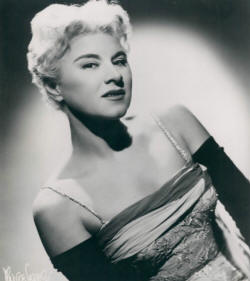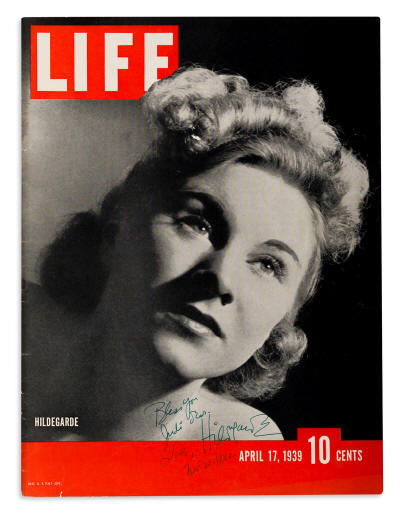

Partner Anna Sosenko
Queer Places:
5444 W Vliet St, Milwaukee, WI 53208

She was born Hildegarde Loretta Sell in Adell, Wisconsin,[1] to Charles F Sell (1865-1933) and Ida Amelia Jermain (1877–1954). Hildegarde was raised in New Holstein, Wisconsin, as a Roman Catholic in a family of German extraction. Charles and Ida moved their family to Milwaukee in 1921. Their new home and store were located at 5444 Vliet Street on the southwestern section of the Washington Heights neighborhood at the cross section of Vliet St. and Hawley Road. In 1921, Vliet Street was, and remains today, the main location for commercial establishments in the residential Washington Heights neighborhood. Hildegarde and her sister Germaine attended St. John‘s Cathedral High School located in downtown Milwaukee at the corner of Jackson and Wells Streets. Hildegarde trained at Marquette University's College of Music in the 1920s.[2]
She worked in vaudeville and traveling shows throughout her career, appearing across the United States and Europe. She was known for 70 years as The Incomparable Hildegarde, a title bestowed on her by columnist Walter Winchell.[3] She was also nicknamed the "First Lady of the Supper Clubs" by Eleanor Roosevelt.[4] She was once referred to as a "luscious, hazel-eyed Milwaukee blonde who sings the way Garbo looks".[5] During the peak of her popularity in the 1930s and 1940s, she was booked in cabarets and supper clubs at least 45 weeks a year. Her recordings sold in the hundreds of thousands, and her admirers ranged from soldiers during World War II to King Gustaf VI Adolph of Sweden and the Duke of Windsor. On some of her recordings, she was accompanied by band leader Carroll Gibbons. During most of the 1940s she appeared on the "Raleigh Room", an NBC Radio program.[4] She wore elegant gowns and long gloves. "Miss Piggy stole the gloves idea from me," she once said. A noted flirt, she told risqué anecdotes while giving long-stemmed roses to men in her audience. During one performance she waltzed with a U.S. Senator. She is credited with starting a single-name vogue among entertainers. Investments and work in ads for a bottled-water company, barley vitamins and a bathtub device gave her a comfortable income through the rock era.[6]

HILDEGARDE (HILDEGARDE LORETTA SELL, 1906-2005)
Three items Signed, or Inscribed and Signed, "Hildegarde": Typed Letter * Complete April 17 1939 issue of Life * Autograph Letter.
The typed letter, to Chaw Mank, apologizing that she was unable to do a radio spot for him, promising to send a photograph of herself holding his book, agreeing to write a foreword for his new book, and giving travel plans. 1 page, 4to, "Palmer House" stationery; some soiling along horizontal folds, faint scattered foxing. The magazine, inscribed on the front cover: "Bless you / Judi dear / Love, Hildegarde." 84 pages. Folio, pictorial wrappers, staple binding; minor smudge to date in inscription. The autograph letter, to "Judi dear," thanking for gifts, asking about her Flordia adventure, expressing excitement about a show she is performing in, and sending a program for the show [not present]. 2 pages, 8vo, written on the recto and verso of a single sheet, personal stationery; horizontal folds. Chicago, 2 September 1957; Np, 20 November 1982; 3 January 1983.Chicago, 2 September 1957; Np, 20 November 1982; 3 January 1983
She appeared on the cover of Life in 1939, and Revlon introduced a Hildegarde shade of lipstick and nail polish. She was an inspiration for Liberace, who once acknowledged her influence on his performances: "Hildegarde was perhaps the most famous supper-club entertainer who ever lived. I used to absorb all the things she was doing, all the showmanship she created. It was marvelous to watch her, wearing elegant gowns, surrounded with roses and playing with white gloves on. They used to literally roll out the red carpet for her".
From the 1950s through the 1970s, in addition to her cabaret performances and record albums, she appeared in a number of television specials and toured with the national company of the Stephen Sondheim musical Follies. She appeared as the celebrity mystery guest on What's My Line? on May 8, 1955. After a question from Bennett Cerf about her handing out roses to which she replied "I don't hand them out, I throw them out!", Dorothy Kilgallen correctly guessed it was her.
In March and April of 1950, Hildegarde and Anna Sosenko moved out of their luxury suite at the Plaza Hotel and into a large apartment.
She sang a presidential nomination campaign song for Margaret Chase Smith’s unsuccessful 1964 campaign for president; the song was called “Leave It to the Girls,” and was written by Gladys Shelley.[7]
Hildegarde never married although she was quoted as saying, "I traveled all my life, met a lot of men, had a lot of romances, but it never worked out. It was always 'hello and goodbye'". She was the business partner and good friend of Anna Sosenko, an aspiring songwriter whom she met at a boarding house in Camden, New Jersey at the beginning of her career.[4] That relationship ended in litigation over the control of receipts from their joint efforts. Hildegarde and Anna stopped working together in 1955, but because of the animosity between the two instead of splitting amicably Anna and Hildegarde fought each other. The fighting caused a delay in their separation which meant their business relationship did not officially dissolve until December 15, 1956. Hildegarde and Anna lived in an apartment in Manhattan which had fourteen rooms and which was full of the memories and art they had collected since they first began living together in 1931. Twenty-five years of their relationship could not be divided, fairly in their opinion so they named their union, ―The Firm of Hildegarde and Anna Sosenko. In this way the material possessions they owned were divided and slated for public sale. All of the contents of their large apartment was auctioned, including their vast and valuable art collection. It was something Anna did not want to happen. She called Hildegarde, crying and saying an auction was not a proper way to separate their belongings. According to Hildegarde in her diaries, Anna resented having to purchase her own belongings at an auction. Obviously, the auction was pushed through by Hildegarde. Throughout the breakup, she blamed Anna for insisting on having everything her way; yet it is clear Hildegarde also wanted the same thing. The auction was advertised and made a private situation into a public occasion with invitations for anyone interested to come view the materials and then to bid on ―All the Properties of the Firm of Hildegarde and Anna Sosenko. The advertisement for the sale listed nearly everything the women owned.
Anna enveloped herself in the stage scene of New York City and produced several different shows. One was a notable production with Ethel Merman and Mary Martin. For this Anna was back in the spotlight and getting accolades for her skills. Anna was the consummate fan and she melded that interest with her love of entertainment and the industry, creating a niche market for herself. She also sold antiques related to the history of American popular culture. She became an entertainment historian and scholar, something noted in her obituary in Billboard on June 24, 2000. Her shop, the Seven Arts Collectors Gallery was located at 8 West 62nd Street in New York City, and as was suggested by the address of her store (on the corner of West 62nd and Central Park West), the shop was very successful.
Her autobiography, Over 50... So What!, was published by Doubleday in 1961.
She died at age 99 in a hospital in Manhattan on July 29, 2005, of natural causes.[4]
My published books: